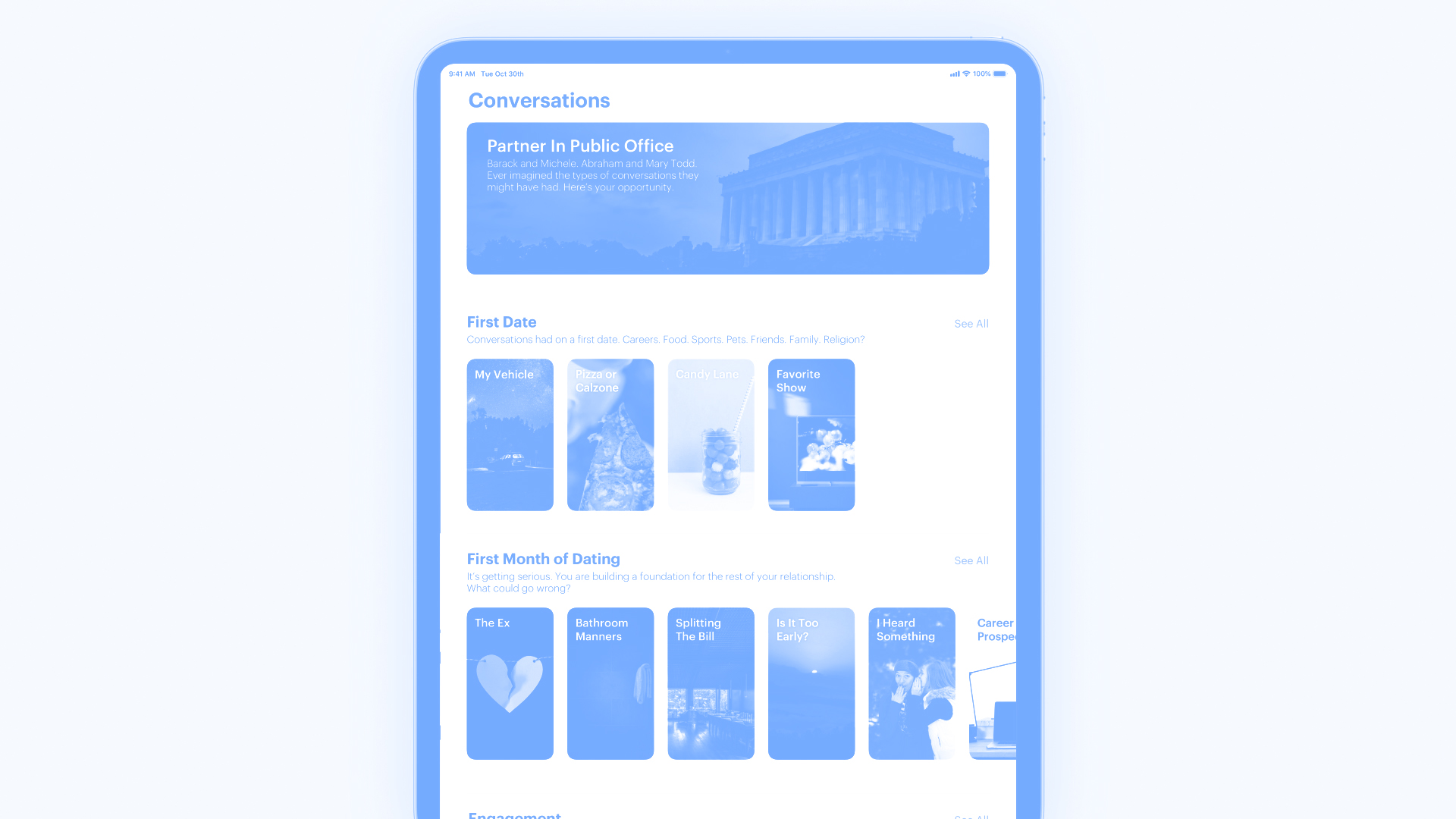The generative phase was dedicated to creating and evaluating artificial agents designed to enhance an intimate partners' capacity for expression and understanding. Each artificial agent was designed to take a unique approach on how an agent could enhance intimate partners' capacity for expression and understanding.
Kinda Human / Generative Phase
Introduction
This phase of research was focused on the prototyping of several artificial agents meant to address different aspects of an intimate relationship through diverse approaches.
Concepts
The How Might I... statements from the exploratory phase informed and inspired a variety of concepts that set the stage for the interfaces I designed and built in the generative phase. Concepts were specifically developed to address a range of the outer level statements of the How Might I... Statement visualization.
















Research Through Prototypes
A large portion of the generative phase was dedicated to conducting investigations through prototypes. It specifically includes the prototyping of artificial agents designed to enhance an intimate partners' capacity for expression and understanding and the evaluation of those prototypes.
Selecting Concepts to Prototype
To determine a set of concepts to prototype, I reviewed and evaluated each concept based on a set of criteria.
- A concept needed to address a range of the How Might I... statementsEach of the sixteen concepts was designed to address a range of the outer level How Might I... statements (i.e., How might I provide a place of reflection for partners and couples? How might I enable a greater understanding of a partner's view?). I selected concepts that address a range of these outer level statements (i.e., no two concepts would be designed to address the same concepts) to ensure that all statements were addressed by at least one concept.
- A concept needed to address a range of components of an intimate relationshipI selected concepts that addressed more than one component of an intimate relationship (i.e., A concept should not only address trust within a relationship, but also address one of the other five components) to create a more holistic experience.
- A concept needed to intervene at different points of a relationship and its conversationsIn order to have a strong impact on partners, no two interfaces should address the same type of couple or intervene at the same point of an intimate relationship. For instance, no two interfaces should be specifically designed for a relationship made up of two young urban professionals or designed for communicating through a messaging client.

How Might I... Statements
I derived a set of five distinct artificial agents designed to support a diversity of contexts and couples. Each agent was designed to enable a partner to better understand themselves, their partner, and their relationship. I believe a partner could then use the information they gain to mature as both an individual and intimate partner (i.e., building the defining qualities of an intimate relationship).
Design of Prototypes
For each concept I created an interactive website or concept video, which simulates a potential situation a couple could find themselves in and highlights how an intervention could aid that situation. My intentions were to create moments where the positives and negatives of an artificial agent become visible and provide users with a way to view conversations, within an intimate relationship and between humans and artificial agents, from a new lens.
I designed the website and videos with the intent of revealing an artificial agent through a larger context that an individual could relate. I did not want to select contexts that individuals could not envision themselves in. For instance I did not want to create a video focused on a couple communicating via email but instead a couple communicating via text, since the majority of couples communicate through text rather than email.
Study Protocol
To evaluate each concept, I ran both online surveys through Mechanical Turk and in-person interviews. The surveys and interviews were used to:
- understand if the concept was effectively addressing the outer level statements and dimensions of an intimate relationship that they were designed to do, and
- whether the concept could be effectively integrated into an intimate relationship.
I also used these insights to understand how each concept could be improved.
I chose Mechanical Turk specifically because it allowed me to affordably reach an audience I would not have access to otherwise. For each concept, I surveyed at least twenty individuals from the U.S.
In-person interviews were designed to help gather details that were not possible through a survey. At least three individuals were interviewed for each concept, with the majority of them being graduate-level design students.
Evaluation of Concepts
Both of the surveys and interviews made use of semantic differentials. By using semantic differentials as a rating scale, I was able to evaluate each concept based on a number of measures, including how useless or valuable, and irresponsible or sensible a user found each concept and agent to be. The semantic differentials also served as a starting point for an in-depth conversation or survey question.

Examples Semantic Differential Questions
Concepts Prototyped
Going into the generative phase of this thesis, I aimed to create and evaluate a diverse set of artificial agents designed to enhance an intimate partners' capacity for expression and understanding. I prototyped five concepts—each addressing different aspects of an intimate relationship—that revealed both opportunities and challenges.
Please explore the concepts below to learn how each addresses unique aspects of an intimate relationship.




